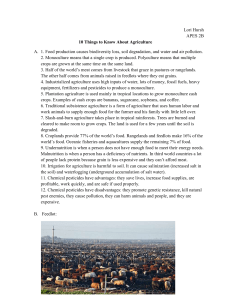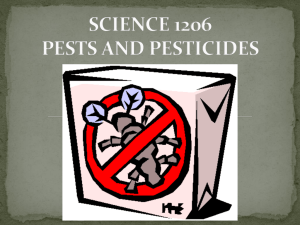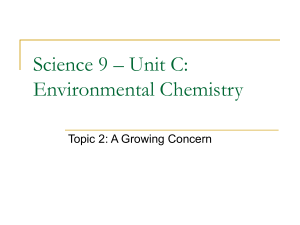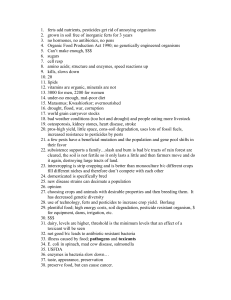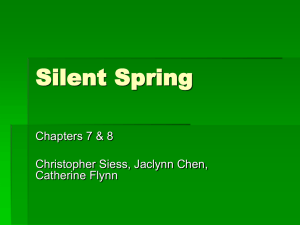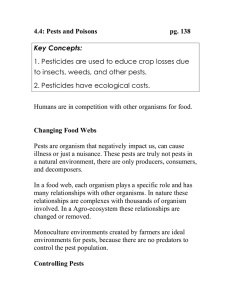Biology Chapter 30
advertisement
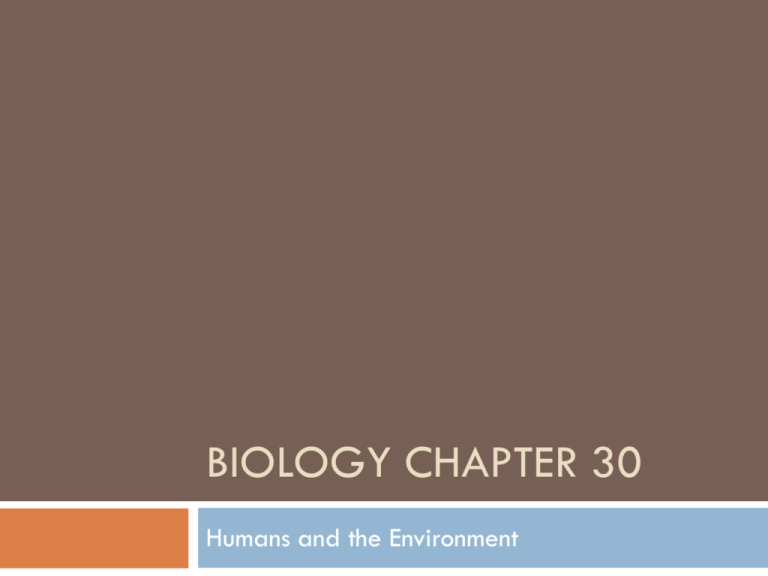
BIOLOGY CHAPTER 30 Humans and the Environment 30.1 The Pesticide Dilemma Advances in agriculture and industry have prolonged and enriched the lives of humans. The by-products produced are undesirable. Pesticides that protect crops from insects also affect the health of birds, fish, and humans. Automobile exhaust, factory emissions, and pesticides are examples of pollution – a contamination of air, water, or soil by materials released into the environment. What is a pesticide? A chemical poison used to kill an unwanted organism. Examples: termites, moths, aphids, weeds, etc. Weeds alone cause 10% loss of agricultural crops per year. We’ve learned in the last few chapters how to keep populations in check. When we plant a single field of one species, pest populations can grow so large as to affect the harvest. Humans probably transferred the pests to other parts of the world. Fruit flies were brought in from fruit smuggled from Hawaii. The flies have no natural predators here. Populations grow unchecked. Japanese beetles and gypsy moths are other examples of transplanted pests. Benefits of pesticides Have enabled us to replace natural ecosystems with farmland, golf courses, lawns, and gardens. Have enabled farmers to produce larger quantities of food. Look at corn harvest: Good year maybe average 220 bushels. Average in 1950: 47 bushels per acre. Problems with pesticides Only 10% lands on pests – other 90% hits harmless organisms, predators of the pests, and gets in the soil and water. The pests that survive become resistant to the pesticides. These reproduce and produce a resistant population over time. Entire ecosystems can be affected by their use. DDT 1939 it was found to be extremely effective in controlling insect pests. Side-effects were not immediately known. Banned in the U.S. now, but used in other parts of the world. Biological resistance built up in the organisms we tried to kill. DDT Biological Magnification DDT remains toxic long after release. Its nonbiodegradeable. DDT biological magnification close to home: Can be seen in red tail hawk population. In small doses, it is not fatal to small birds and other animals. But it is still present in the tissues. Concentration gets higher as we move up the food chain. When I was growing up, there were never any red tail hawks in Iowa. Now you can’t drive a mile without seeing one. Alternatives to pesticides Cultural controls – devising methods that discourage pest growth in the first place. Biological control – introducing predators from another area to keep pest population in check. Autocidal control – sterilizing male species and introducing them into an area. Integrated pest management – system using all three of these controls to check populations. 30.2 Pollution of Air and Water One of the chief causes of air pollution is burning of fossil fuels. By-products include carbon monoxide, carbon dioxide, sulfur dioxide, nitrogen oxides, lead compounds, and hydrocarbons. All of these are considered pollutants. Air Pollution Carbon monoxide – CO bonds with hemoglobin in the blood. It takes up space reserved for oxygen. Nitrogen oxides – can damage lungs, cause eyes to tear, and contributes to ozone. Ozone layer up in the atmosphere is actually a good thing. Blocks out harmful UV rays. Chloroflourocarbons (CFC’s) can damage the ozone layer. Acid Rain Rainfall with a pH of 5.5 and below is considered acid rain. Can wash nutrients out of the soil. Can cause lakes to become dead zones. Can alter the pH of the soil over time. Global Warming Book talks about global warming next, but we will study this on our own after this chapter. 30.3 Conservation of Resources Genetic Engineering – 200 bushels of beans/ acre Focusing on renewable resources more. Minimizing erosion. Using alternative fuels (nuclear, solar, and hydroelectric energy) Conserving wildlife and habitat.





